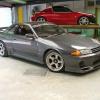Can You Help Me Identify This Plug? Wiring R32 Rb20Det
Announcements
-
Similar Content
-
Latest Posts
-
There's more than one way to skin that cat, and most of the sump Maatouks have done will be GTR sumps. They are HUGE in GTR drag racing here.
-
Yeah...I always start at the shift solenoids, because there's only a few reasons these will spook into limp mode, and bad shift solenoids is one ~ the other can be the shift control module (if you have steering wheel shift buttons)...it's easier to eliminate the solenoids first.
-
By cabramatta · Posted
Might piggy back off this thread since there's been a good discussion about PWM. I purchased a Walbro 460 F90000267 and have been looking into PWM to understand it. It was purchased more of a future proof as my original OEM fuel pump died (r33 below 200kw) and figured I'd just upgrade it to this. That's when it hit me that a pump this big can cause more dramas with such high amperage draw and heating of the fuel pump being on 100% all the time in such a mild setup. I have a Nexus R3 and slowly collecting power mods but I was looking into the PWM feature on the NSP software: Then looking at the graph from the fuel pump: Am I safe to assume reducing duty cycle to 50% for example would make the pump run like a 230/lph ? Where does the PWM come in all of this ? I've gone down the rabbit hole of PWM fuel pumps and it seems there are many differing opinions on how to go about it 😅 -
Thank you, this will keep me busy for a bit. I will update progression.
-
That specific one would be an exchange part, meaning I'd have to send mine to them. Plus it looks like a non AWD sump, which won't work for me. There is one or two shops in my country that I can ask to do a sump extension job and it'd most likely end up being cheaper than sending mine to AUS or NZ and getting one back, and quicker too.
-





Recommended Posts
Create an account or sign in to comment
You need to be a member in order to leave a comment
Create an account
Sign up for a new account in our community. It's easy!
Register a new accountSign in
Already have an account? Sign in here.
Sign In Now